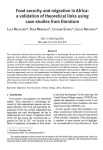Mulazzani L., Manrique R., Stancu C., Malorgio G. (2020). Food security and migration in Africa: a validation of theoretical links using case studies from literature. New Medit, 01/06/2020, vol. 19, n. 2, p. 19-36.
https://doi.org/10.30682/nm2002b
https://doi.org/10.30682/nm2002b
| Titre : | Food security and migration in Africa: a validation of theoretical links using case studies from literature (2020) |
| Auteurs : | L. Mulazzani ; R. Manrique ; C. Stancu ; G. Malorgio |
| Type de document : | Article |
| Dans : | New Medit (vol. 19, n. 2, June 2020) |
| Article en page(s) : | p. 19-36 |
| Langues : | Anglais |
| Langues du résumé : | Anglais |
| Catégories : |
Catégories principales 13 - QUESTION SOCIALES ; 13.2 - Migrations InternationalesThésaurus IAMM SECURITE ALIMENTAIRE ; MIGRATION ; CHANGEMENT CLIMATIQUE ; MIGRATION CLIMATIQUE ; STRUCTURE FONCIERE ; PAUVRETE ; ALIMENTATION HUMAINE ; AFRIQUE |
| Résumé : | The connection between food security and migration is increasingly discussed by both international agencies and academic literature. However, despite several improvements, we continue to know little about the complex causal-effect relations that link these aspects and, in particular, how much migration patterns are affected by food security issues and how much, as a feedback, migration can affect food security, on both the origin and destination areas. This paper aims firstly to draw a general framework of this nexus and then to validate it using empirical literature on the African continent. A few common points can be emphasized for the continent: due to structural and familiar characteristics, different strategies based on opportunity costs or risk minimization (including food security aspects) may emerge; individuals often migrate following household strategies; multi-nodal households are emerging; land grabbing and land tenure security represent important drivers to be considered; emergencies or critical situations often cause the erosion of women rights. In many situations, the poverty trap prevents most food insecure households to leave marginal lands. |
| Cote : | En ligne |
| URL / DOI : | https://doi.org/10.30682/nm2002b |







